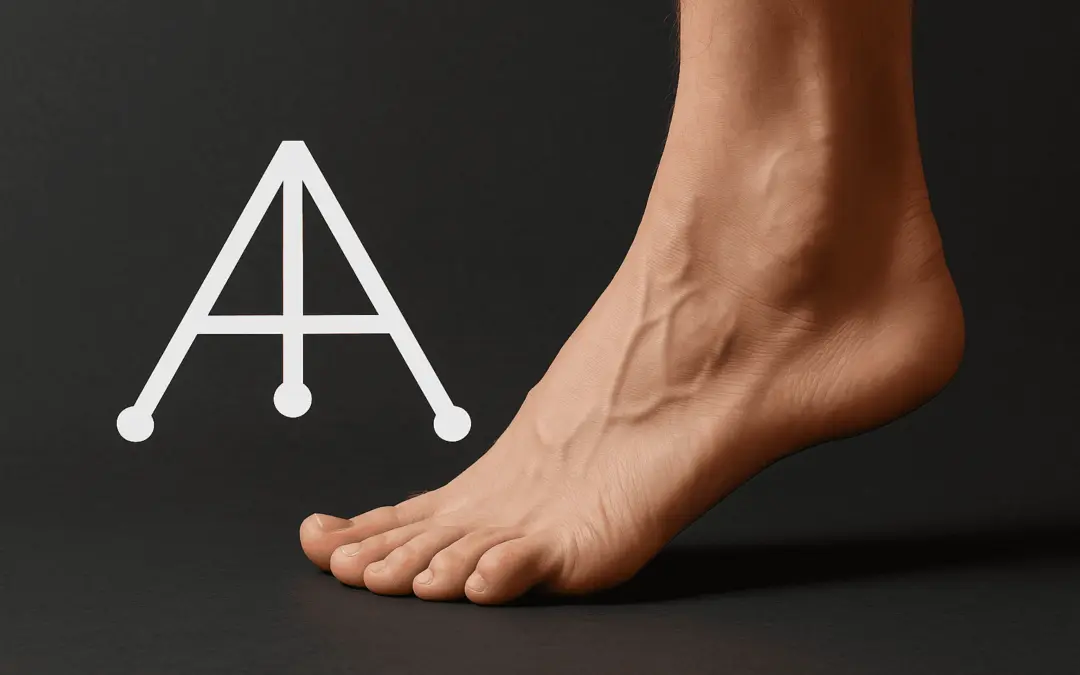Imagine standing barefoot on a balance beam. Now close your eyes.
What’s keeping you upright isn’t just your muscles—it’s an ancient blueprint wired into your nervous system. And it all starts with your feet.
But not just any part of the foot—the tripod.
This isn’t some mystical metaphor. The tripod is real: three contact points on the bottom of your foot that anchor your entire body. When these points are aligned and activated, you gain access to powerful stability, effortless movement, and something even deeper—neurological calm.
Let’s break it down.
What Is the Foot Tripod?
Think of the foot like a camera tripod: three contact points distribute your weight evenly and provide multidirectional stability.
-
1st metatarsal head (under the big toe)
-
5th metatarsal head (under the pinky toe)
-
Calcaneus (your heel)
When all three are grounded, the rest of your body can stack and stabilize above it. Your arches lift. Your joints align. Your nervous system relaxes. But if even one of those points collapses, your balance, posture, and coordination fall apart.
8,000 Nerves and the Ontogeny of Balance
Here’s where it gets wild: your feet contain more than 8,000 nerve endings.
These aren’t just for feeling sand between your toes. They are part of your body’s sensory surveillance system—sending real-time updates to your brain about pressure, position, and movement. It’s like having Wi-Fi in your feet, constantly syncing with your balance center.
And this connection starts early—really early.
According to the DNS model (Dynamic Neuromuscular Stabilization), the functional development of our postural and movement systems begins in the first year of life. Your brain learns to organize and control movement based on primitive reflexes and sensory feedback, including what’s coming in from your feet. At 3 months, sagittal stabilization emerges. By 8 months, locomotion begins.
But here’s the kicker: if these developmental stages are skipped, rushed, or disorganized (which happens often in our chair-bound culture), we may lose access to that deep, subconscious stability. The foot tripod never gets “plugged in.”
The Foot, the ANS, and the Fight for Balance
Every step you take, your body has to answer one question: Am I safe?
The Autonomic Nervous System (ANS) is constantly scanning the environment through proprioception—especially from your feet. If your tripod is off, you may not even consciously notice, but your Sympathetic Nervous System (SNS) does. It goes on alert.
You lose access to diaphragmatic breathing, joint centration, and smooth movement. This is why poor foot stability is linked to increased anxiety, tight hip flexors, shallow breathing, and even chronic pain.
But when your tripod is on point? The Parasympathetic Nervous System (PNS) kicks in. You move from survival to control, chaos to coherence.
Biomechanical Equilibrium Begins at the Foot
Let’s go back to your Ruc Pack™. You’re hiking with a water bottle dangling from your chest strap.
If your tripod is solid, that bottle barely moves—because your body is transmitting force efficiently from foot to head. Each step is a transfer of diagonal, rotational force—what DNS calls functional joint centration.
But if your heel doesn’t land neutrally, or your toes collapse inward, that force has nowhere to go. Your knee collapses, your hip rotates, your core twists—and now that bottle swings like a wrecking ball.
When the tripod is engaged, you create centrifugal stillness. Your body is in motion, but balanced. Every force that tries to throw you off is matched and neutralized. This is true biomechanical equilibrium.
DNS, Movement Literacy, and Coherence
DNS teaches that your body matures through ontogenic stages—each one wiring your brain for stability, balance, and movement. These are not just motor milestones; they are neural frameworks.
If the tripod isn’t present during the crawling or standing phase, your brain may never fully learn how to stabilize from the ground up. This creates compensations, inefficiencies, and eventually injuries. You can train hard, but if the base is faulty, the system leaks.
Training the tripod—literally learning to feel and activate the three points of foot contact—reinstates that original code. It’s movement re-education: when your nervous system finally senses safety, it stops bracing. Muscles relax. Movement improves. Behavior changes.
How to Train the Tripod
Barefoot work – Ditch the shoes. Feel the floor. Let your feet spread and adapt.
Tripod stance drills – Practice grounding all three points. Weight shift slowly side to side and forward/back while maintaining even contact.
DNS positions – Integrate foot tripod awareness into 3-month, 6-month, and 8-month DNS postures. Feel how the foot connects to core activation.
Load awareness – Use tools like Ruc Packs™, bands, or offset weights to challenge your tripod stability in dynamic movement.
Takeaway: The Truth is Under Your Feet
The tripod isn’t optional. It’s primal. It’s programmed into your brain before you ever take your first step.
By restoring the tripod, you’re not just fixing a foot issue. You’re resetting your entire system—nervous, muscular, postural, and emotional. You’re teaching your body to move with confidence, stability, and grace.
And when that water bottle on your chest stops swinging?
That’s your body saying, “I’ve got this.”
References:
-
Kolář P. et al. (2014). Dynamic Neuromuscular Stabilization: Principles of DNS.
-
McKeon P. O. & Hertel J. (2008). Systematic Review of Postural Control and Sensorimotor Function. Journal of Athletic Training.
-
Kolar, P., Sulc J., Kyncl M., (2012). Stabilizing function of the diaphragm: dynamic MRI and synchronized spirometric assessment. J Appl Biomech.



